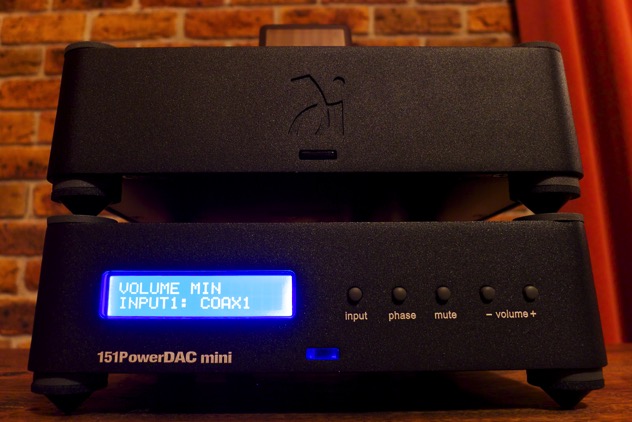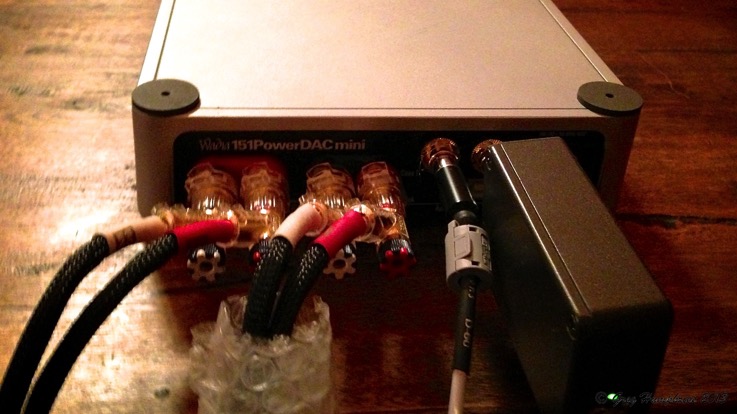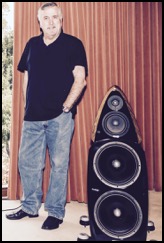My Wadia 151PowerDACmini Review
Many of you will know that I am big fan of Wadia Digital having owned one of their high-end integrated CD transport/DAC combos for the last 15 years. A 170iTransport iPod dock graces my system as well.
My latest piece of Wadia gear is the 151PowerDACmini. And it is a visual and sonic beauty!

The Wadia 151 PowerDAC mini - 2013
The PowerDAC is DAC, digital pre-amplifer with a stereo power amplifier module. It supports only digital inputs (2x COAX, USB and TOSLINK), has no digital or analog outputs, a single pair of speaker binding posts and an IEC receptacle. It doesn't sound much but it is such a compact unit (20 centimetres square) so the rear panel gets pretty busy with 'audiophile' sized cables and connectors.
The specs are pretty straight forward. The 151 PowerDAC has an internal power supply (not too beefy as the entire unit weighs less than 3 kgs), USB is asynchronous and maxes out at 96/24 (although the Wadia DigiMaster software up samples to 24bit/384k before outputting), total power from the Class-D digital amp module is around 25 wpc at 8 ohms (50 wpc at 4 ohms). And that is about it. The only other feature to note is that like all Wadia players the 151 comes with a phase polarity switch to ensure playback can be matched to the source if phase is an issue.
The unit was simple plug and play to get going. Attach your connection of choice, select the correct input via the front panel or remote control and press play on your source and beautiful sound emanates from your speakers, in my case the Zu Audio Definition Mk1.5s. I have used the 170i dock, the Wadia 861SE as a transport (via it's Digital Out COAX output) and a MacBook Pro running Fidelia via an Audiophilleo2 (USB-to-S/DIF converter) as sources into the PowerDAC and they have all worked flawlessly with easy connectivity and setup. I ran the PowerDAC for over 150 hours before I commenced my evaluation and review.
So how does the 151 PowerDAC sound? Pretty darn good actually.
Belying it's solid state / digital amp heritage, the sound is dynamic and full, and not harsh or overly extended in the higher frequencies. I found the bass to be a real feature of the PowerDAC, deep, solid and tuneful providing a sound platform for the mids and highs o be layered upon. The overall sound is very smooth and 'listenable' with no apparent artefacts, gaps or quirks that leave you wanting for 'more of this or more of that'. Information and detail retrieval and playback is probably the PowerDAC's biggest strength with whatever is on the disc or FLAC file rendered completely and presenting it back as a whole for the listener's enjoyment. A very pleasant surprise on one of my favourite test tracks, 'Two Roads' by Phil Manning, was the clarity of the two voices in the chorus that can be hard to discern through lesser playback systems, even when listening hard via headphones. Transparency was also evident with the PowerDAC easily showing the performance and sonic differences of the multiple sources (both hardware and software) that I tried with it. Not surpassingly, power handling / headroom was not an issue in my medium sized room through the 101db efficient Zus.

The busy rear panel, TOSLINK and USB inaccessible - 2013
Compared to my Wadia 861SE player via my Supratek Sauvignon/Malbec tube combo, the PowerDAC throws a somewhat smaller soundstage. The image is properly centred and rock solid but clearly inside the speakers and emanating from a noticeably smaller 'window'.
Overall, I am very happy with my purchase from the fine folk at Tivoli HiFi in Melbourne. It may not see too much time in the 'Big Rig' but will certainly be the heart of my 'Simple & Small Second System' paired with my Red Rose Music stand mounts.
So in summary, the Wadia PowerDAC 151 mini is not SoTA in terms of sound quality and you must live with the limitations of it's digital inputs. But for modest dollars it is a very attractive and compact one-box DAC / amplifier solution that will drive most real world speaker loads in small to medium sized rooms delivering very high quality digital decoding from a range of sources and makes the most enjoyable music. To round out the value equation, Wadia has an enviable reputation for quality and longevity and my unit appears well made, runs silently with all controls and connectors having a solid feel.
Just add a computer and speakers and you have a gateway to high end sound. Recommended!!
Don't just take my word for it, other reviewers at Home Theatre Review and Tone Audio seem to like the 151 as well. The official PowerDAC 151 mini product page at Wadia can be found here.
